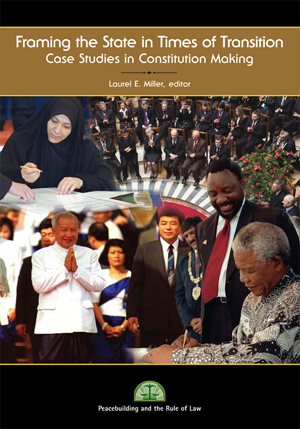Framing the State in Times of Transition
 Analyzing nineteen cases, Framing the State in Times of Transition offers the first in-depth, practical perspective on the implications of constitution-making procedure, and explores emerging international legal norms. | Learn more
Analyzing nineteen cases, Framing the State in Times of Transition offers the first in-depth, practical perspective on the implications of constitution-making procedure, and explores emerging international legal norms. | Learn more
Online Chapters
- PART I: THEORY AND CONCEPTS
- PART II: AFRICA
- PART III: ASIA AND THE PACIFIC
- PART IV: EUROPE
- PART V: LATIN AMERICA
- PART VI: MIDDLE EAST AND CENTRAL ASIA
- PART VII: CONCLUSION
1. Norms of International Law Relating to the Consitution-Making Process
2. Constitution Making and the Right to Take Part in a Public Affair
3. Constitution Making in Eritrea: A Process-Driven Approach
5. Creating the Birth Certificate of a New South Africa: Constitution Making after Apartheid
6. The Politics of Constitution Making in Uganda
7. Zimbabwe's Unfulfilled Struggle for a Legitimate Constitutional Order
PART III: ASIA AND THE PACIFIC
8. The Process of Creating a New Constitution in Cambodia
9. East Timor's Constitutional Passage to Independence
10. Between Coups: Constitution Making in Fiji
11. The Drafting Process for the 1998 Albanian Constitution
12. The Dayton Constitution of Bosnia and Herzegovina
13. Constitutional Making and Transitional Politics in Hungary
14. Constitution Making, Peace Building, and National Reconciliation: The Experience of Poland
15. Constitution Making and Democratization: The Spanish Paradigm
16. Conflict Resolution and Constitutionalism: The Making of the Brazilian Constitution of 1988
18. The Nicaraguan Constitutional Experience: Process, Conflict, Contradictions, and Change
PART VI: MIDDLE EAST AND CENTRAL ASIA
20. Big Tent, Small Tent: The Making of a Constitution in Afghanistan
21. Deconstituting Mesopotamia: Cutting a Deal on the Regionalization of Iraq
22. Designing Constitution-Making Processes: Lessonsfrom the Past, Questions for the Future
